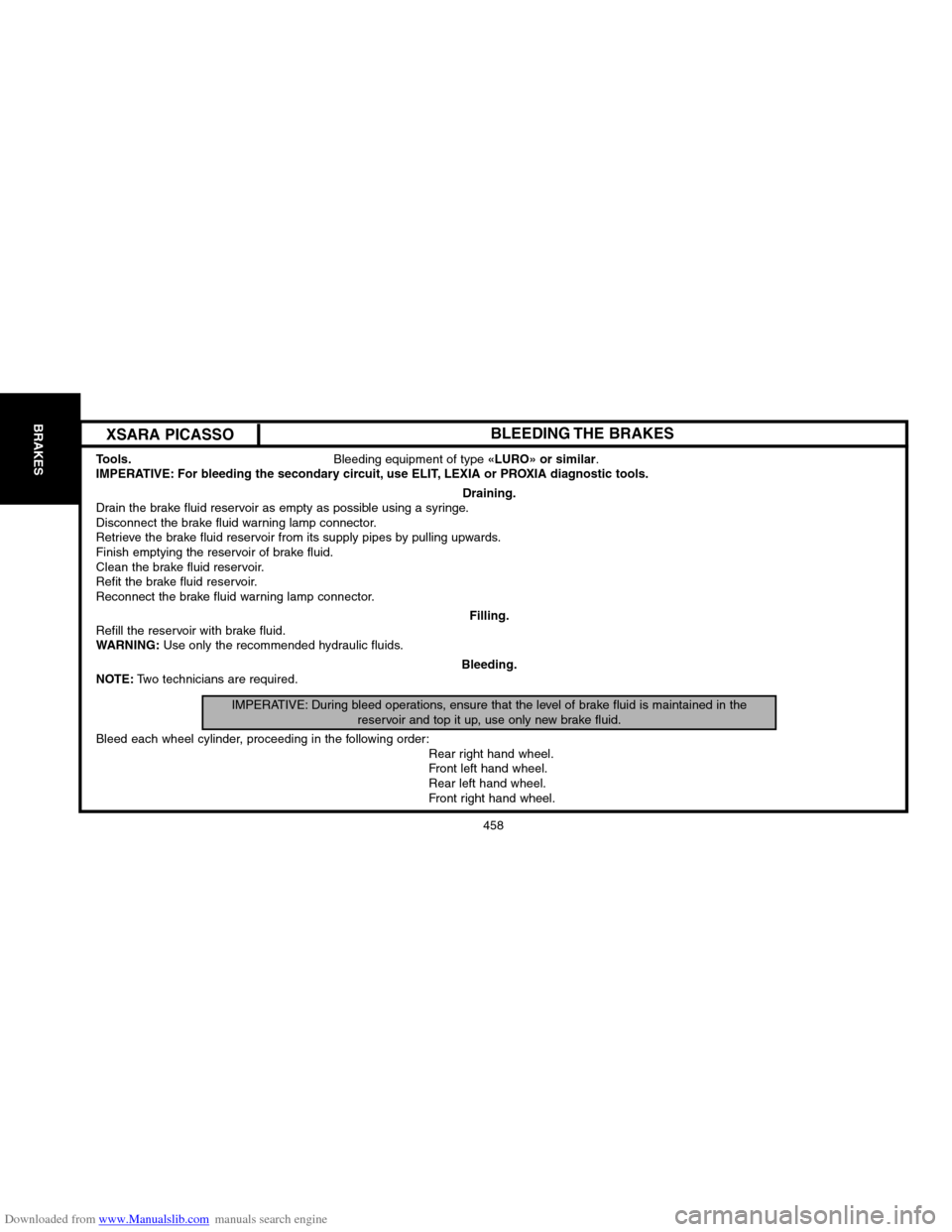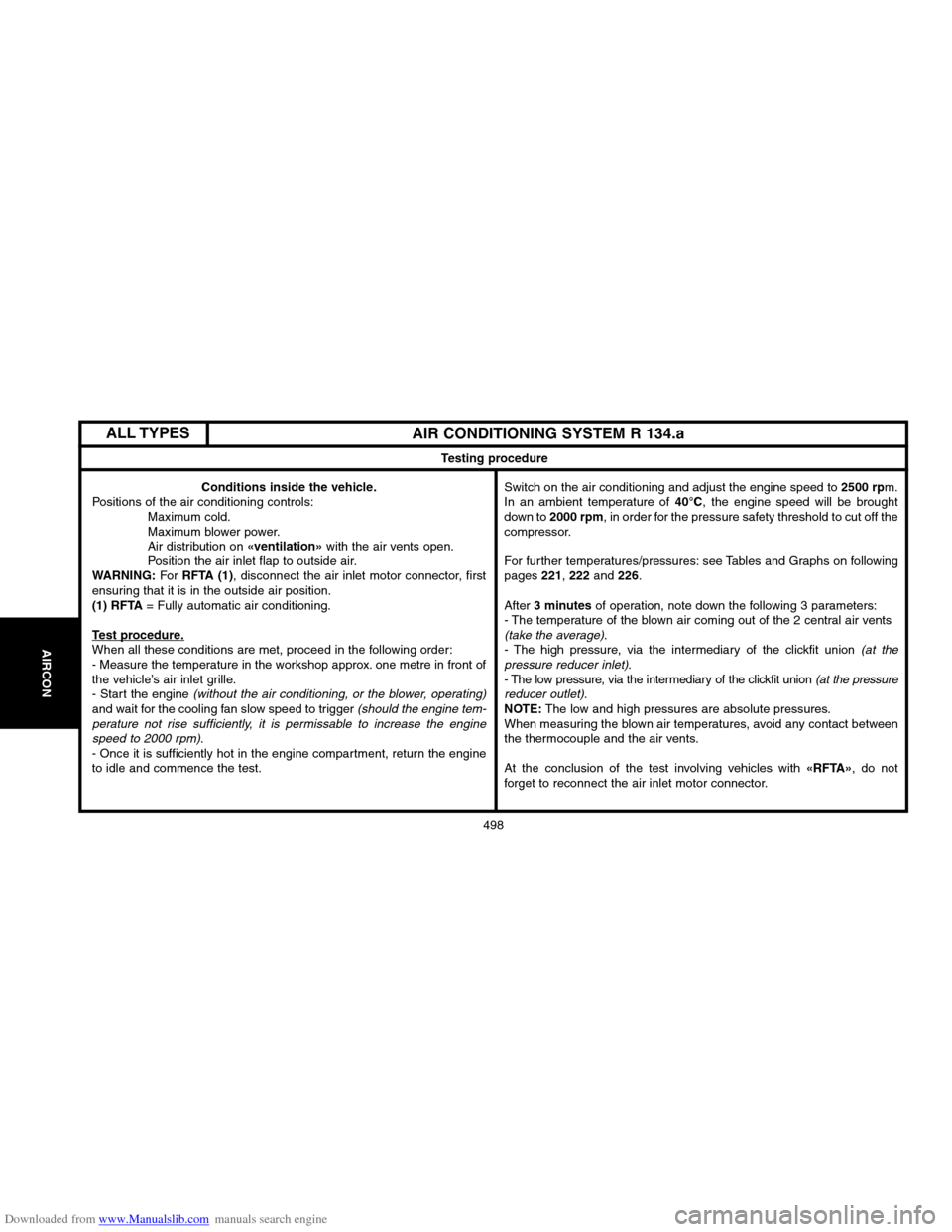front wing Citroen XSARA PICASSO 2004 1.G User Guide
[x] Cancel search | Manufacturer: CITROEN, Model Year: 2004, Model line: XSARA PICASSO, Model: Citroen XSARA PICASSO 2004 1.GPages: 523, PDF Size: 10.32 MB
Page 462 of 523

Downloaded from www.Manualslib.com manuals search engine 458
BRAKESBLEEDING THE BRAKESXSARA PICASSO
Tools.Bleeding equipment of type «LURO» or similar.IMPERATIVE: For bleeding the secondary circuit, use ELIT, LEXIA or PROXIA diagnostic tools.
Draining.
Drain the brake fluid reservoir as empty as possible using a syringe.
Disconnect the brake fluid warning lamp connector.Retrieve the brake fluid reservoir from its supply pipes by pulling upwards.
Finish emptying the reservoir of brake fluid.
Clean the brake fluid reservoir.
Refit the brake fluid reservoir.
Reconnect the brake fluid warning lamp connector.
Filling.Refill the reservoir with brake fluid.WARNING:Use only the recommended hydraulic fluids.
Bleeding.
NOTE:Two technicians are required.
IMPERATIVE:During bleed operations, ensure that the level of brake fluid is maintained in the
reservoir and top it up, use only new brake fluid.
Bleed each wheel cylinder, proceeding in the following order:
Rear right hand wheel.
Front left hand wheel.
Rear left hand wheel.
Front right hand wheel.
Page 502 of 523

Downloaded from www.Manualslib.com manuals search engine 498
AIRCONAIRCON
AIR CONDITIONING SYSTEM R 134.a
Testing procedure
Conditions inside the vehicle.
Positions of the air conditioning controls:
Maximum cold.
Maximum blower power.
Air distribution on
«ventilation»with the air vents open.
Position the air inlet flap to outside air.
WARNING:For RFTA (1), disconnect the air inlet motor connector, first
ensuring that it is in the outside air position.
(1) RFTA= Fully automatic air conditioning.
Test procedure.When all these conditions are met, proceed in the following order:
� Measure the temperature in the workshop approx. one metre in front of
the vehicle’s air inlet grille.
� Start the engine
(without the air conditioning, or the blower, operating)and wait for the cooling fan slow speed to trigger (should the engine tem�
perature not rise sufficiently, it is permissable to increase the engine
speed to 2000 rpm)
.
� Once it is sufficiently hot in the engine compartment, return the engine
to idle and commence the test.Switch on the air conditioning and adjust the engine speed to
2500 rpm.
In an ambient temperature of 40°C, the engine speed will be brought
down to 2000 rpm, in order for the pressure safety threshold to cut off the
compressor.
For further temperatures/pressures: see Tables and Graphs on following
pages
221, 222 and 226.
After
3 minutesof operation, note down the following 3 parameters:
� The temperature of the blown air coming out of the 2 central air vents
(take the average).
� The high pressure, via the intermediary of the clickfit union (at the
pressure reducer inlet).
� The low pressure, via the intermediary of the clickfit union (at the pressure
reducer outlet).NOTE:The low and high pressures are absolute pressures.
When measuring the blown air temperatures, avoid any contact between
the thermocouple and the air vents.
At the conclusion of the test involving vehicles with
«RFTA»
ALL TYPES